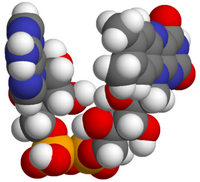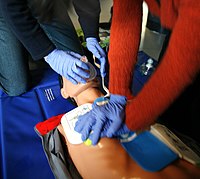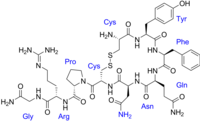
Assessment of Cerebral Blood Oxygenation by Near-Infrared Spectroscopy before and after Resuscitation in a Rat Asphyxia Cardiac Arrest Model.
Sign Up to like & getrecommendations! Published in 2021 at "Advances in experimental medicine and biology"
DOI: 10.1007/978-3-030-48238-1_49
Abstract: Clinical investigators have focused on the real-time evaluation of cerebral blood oxygenation (CBO) by near-infrared spectroscopy (NIRS) during cardiopulmonary resuscitation (CPR). A previous study showed that an abrupt increase of oxy-hemoglobin (Hb) level and tissue… read more here.
Keywords: oxygenation; cpr; spectroscopy; rosc ... See more keywords

Normoxic post-ROSC ventilation delays hippocampal CA1 neurodegeneration in a rat cardiac arrest model, but does not prevent it
Sign Up to like & getrecommendations! Published in 2020 at "Experimental Brain Research"
DOI: 10.1007/s00221-020-05746-6
Abstract: The European Resuscitation Guidelines recommend that survivors of cardiac arrest (CA) be resuscitated with 100% O 2 and undergo subsequent—post-return of spontaneous circulation (ROSC)—reduction of O 2 supply to prevent hyperoxia. Hyperoxia produces a “second… read more here.
Keywords: post rosc; rosc ventilation; cardiac arrest; post ... See more keywords

Effects of Mild Hypothermia on Cerebral Large and Small Microvessels Blood Flow in a Porcine Model of Cardiac Arrest
Sign Up to like & getrecommendations! Published in 2017 at "Neurocritical Care"
DOI: 10.1007/s12028-017-0395-6
Abstract: BackgroundThe effect of mild hypothermia (MH) on microcirculation after resuscitation from cardiac arrest is controversial. The aim of this study was to determine whether MH improves or aggravates the disturbance of cerebral microcirculation.MethodsTwenty domestic male… read more here.
Keywords: blood flow; hypothermia; mild hypothermia; group ... See more keywords

Cerebral tissue oximetry levels during prehospital management of cardiac arrest - A prospective observational study.
Sign Up to like & getrecommendations! Published in 2018 at "Resuscitation"
DOI: 10.1016/j.resuscitation.2018.05.014
Abstract: INTRODUCTION Near-infrared spectroscopy (NIRS) enables continuous monitoring of regional oximetry (rSO2). The aim of this study was to describe dynamics of regional cerebral oximetry levels during out of hospital cardiac arrest (OHCA) resuscitation, specifically around… read more here.
Keywords: cpr; study; cardiac arrest; oximetry levels ... See more keywords

The effect of dispatcher-assisted cardiopulmonary resuscitation on early defibrillation and return of spontaneous circulation with survival.
Sign Up to like & getrecommendations! Published in 2019 at "Resuscitation"
DOI: 10.1016/j.resuscitation.2019.01.004
Abstract: BACKGROUND Dispatcher-assisted cardiopulmonary resuscitation (DA-CPR) programs are implemented to augment bystander CPR and improve outcomes of patients with out-of-hospital cardiac arrest (OHCA). To understand the pathway of how DA-CPR improves outcomes of OHCA, we aimed… read more here.
Keywords: cpr; defibrillation; bystander cpr; rosc ... See more keywords

Capnography: A support tool for the detection of return of spontaneous circulation in out-of-hospital cardiac arrest.
Sign Up to like & getrecommendations! Published in 2019 at "Resuscitation"
DOI: 10.1016/j.resuscitation.2019.03.048
Abstract: BACKGROUND Automated detection of return of spontaneous circulation (ROSC) is still an unsolved problem during cardiac arrest. Current guidelines recommend the use of capnography, but most automatic methods are based on the analysis of the… read more here.
Keywords: detection; detection return; cardiac arrest; rosc ... See more keywords

The impact of double sequential external defibrillation on termination of refractory ventricular fibrillation during out-of-hospital cardiac arrest.
Sign Up to like & getrecommendations! Published in 2019 at "Resuscitation"
DOI: 10.1016/j.resuscitation.2019.04.038
Abstract: BACKGROUND Despite significant advances in resuscitation efforts, there are some patients who remain in ventricular fibrillation (VF) after multiple shocks during out-of-hospital cardiac arrest (OHCA). Double sequential external defibrillation (DSED) has been proposed as a… read more here.
Keywords: standard defibrillation; defibrillation; rosc; ventricular fibrillation ... See more keywords

Lactate and hypotension as predictors of mortality after in-hospital cardiac arrest.
Sign Up to like & getrecommendations! Published in 2020 at "Resuscitation"
DOI: 10.1016/j.resuscitation.2020.10.018
Abstract: AIM Guidance on post-cardiac arrest prognostication is largely based on data from out-of-hospital cardiac arrest (OHCA), despite clear differences between the OHCA and in-hospital cardiac arrest (IHCA) populations. Early prediction of mortality after IHCA would… read more here.
Keywords: hospital cardiac; lactate; mortality; cardiac arrest ... See more keywords

Time to Return of Spontaneous Circulation and Survival: When to Transport in out-of-Hospital Cardiac Arrest?
Sign Up to like & getrecommendations! Published in 2020 at "Prehospital Emergency Care"
DOI: 10.1080/10903127.2020.1752868
Abstract: Abstract Background In out-of-hospital cardiac arrest (OHCA), 10–50% of patients have return of spontaneous circulation (ROSC) before hospital arrival. It is important to investigate the relation between time-to-ROSC and survival to determine the optimal timing… read more here.
Keywords: time rosc; transport; time; hospital ... See more keywords

Time to Return of Spontaneous Circulation (ROSC) and Survival: Tissue and Brain Perfusion Is Probably More Important than ROSC
Sign Up to like & getrecommendations! Published in 2021 at "Prehospital Emergency Care"
DOI: 10.1080/10903127.2021.1979144
Abstract: To The Editor: Recently in the Journal, De Graaf et al. (1), reported that survival from out-of-hospital cardiac arrest (OHCA) significantly decreases with increasing time to return of spontaneous circulation (ROSC) and that 8minutes was… read more here.
Keywords: time; return spontaneous; rosc; time return ... See more keywords

Response to Letter to the Editor Dr. Mosesso
Sign Up to like & getrecommendations! Published in 2021 at "Prehospital Emergency Care"
DOI: 10.1080/10903127.2021.1979145
Abstract: In the management of out-of-hospital cardiac arrest (OHCA) there are two competing “interests”: to spend time on scene to allow a patient to achieve return of spontaneous circulation (ROSC), (“stay and play”) and not losing… read more here.
Keywords: hospital; study; rosc; scene ... See more keywords